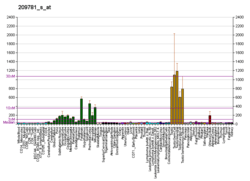KHDRBS3
KH domain-containing, RNA-binding, signal transduction-associated protein 3 is a protein that in humans is encoded by the KHDRBS3 gene.[3][4][5]
Interactions
KHDRBS3 has been shown to interact with SIAH1.[6][7]
References
- ↑ "Human PubMed Reference:".
- ↑ "Mouse PubMed Reference:".
- ↑ Venables JP, Vernet C, Chew SL, Elliott DJ, Cowmeadow RB, Wu J, Cooke HJ, Artzt K, Eperon IC (Jul 1999). "T-STAR/ETOILE: a novel relative of SAM68 that interacts with an RNA-binding protein implicated in spermatogenesis". Hum Mol Genet. 8 (6): 959–69. PMID 10332027. doi:10.1093/hmg/8.6.959.
- ↑ Lee J, Burr JG (Jan 2000). "Salpalpha and Salpbeta, growth-arresting homologs of Sam68". Gene. 240 (1): 133–47. PMID 10564820. doi:10.1016/S0378-1119(99)00421-7.
- ↑ "Entrez Gene: KHDRBS3 KH domain containing, RNA binding, signal transduction associated 3".
- ↑ Rual JF, Venkatesan K, Hao T, Hirozane-Kishikawa T, Dricot A, Li N, Berriz GF, Gibbons FD, Dreze M, Ayivi-Guedehoussou N, Klitgord N, Simon C, Boxem M, Milstein S, Rosenberg J, Goldberg DS, Zhang LV, Wong SL, Franklin G, Li S, Albala JS, Lim J, Fraughton C, Llamosas E, Cevik S, Bex C, Lamesch P, Sikorski RS, Vandenhaute J, Zoghbi HY, Smolyar A, Bosak S, Sequerra R, Doucette-Stamm L, Cusick ME, Hill DE, Roth FP, Vidal M (Oct 2005). "Towards a proteome-scale map of the human protein-protein interaction network". Nature. 437 (7062): 1173–8. PMID 16189514. doi:10.1038/nature04209.
- ↑ Venables JP, Dalgliesh C, Paronetto MP, Skitt L, Thornton JK, Saunders PT, Sette C, Jones KT, Elliott DJ (Jul 2004). "SIAH1 targets the alternative splicing factor T-STAR for degradation by the proteasome". Hum. Mol. Genet. 13 (14): 1525–34. PMID 15163637. doi:10.1093/hmg/ddh165.
Further reading
- Di Fruscio M, Chen T, Richard S (1999). "Characterization of Sam68-like mammalian proteins SLM-1 and SLM-2: SLM-1 is a Src substrate during mitosis.". Proc. Natl. Acad. Sci. U.S.A. 96 (6): 2710–5. PMC 15834
 . PMID 10077576. doi:10.1073/pnas.96.6.2710.
. PMID 10077576. doi:10.1073/pnas.96.6.2710. - Venables JP, Elliott DJ, Makarova OV, Makarov EM, Cooke HJ, Eperon IC (2000). "RBMY, a probable human spermatogenesis factor, and other hnRNP G proteins interact with Tra2beta and affect splicing.". Hum. Mol. Genet. 9 (5): 685–94. PMID 10749975. doi:10.1093/hmg/9.5.685.
- Stoss O, Olbrich M, Hartmann AM, Konig H, Memmott J, Andreadis A, Stamm S (2001). "The STAR/GSG family protein rSLM-2 regulates the selection of alternative splice sites.". J. Biol. Chem. 276 (12): 8665–73. PMID 11118435. doi:10.1074/jbc.M006851200.
- Sugimoto Y, Morita R, Amano K, Shah PU, Pascual-Castroviejo I, Khan S, Delgado-Escueta AV, Yamakawa K (2001). "T-STAR gene: fine mapping in the candidate region for childhood absence epilepsy on 8q24 and mutational analysis in patients.". Epilepsy Res. 46 (2): 139–44. PMID 11463515. doi:10.1016/S0920-1211(01)00274-1.
- Kool J, van Zaane W, van der Eb AJ, Terleth C (2002). "Down-regulation of T-STAR, a growth inhibitory protein, after SV40-mediated immortalization.". Cell Growth Differ. 12 (11): 535–41. PMID 11714634.
- Reddy TR, Suhasini M, Xu W, Yeh LY, Yang JP, Wu J, Artzt K, Wong-Staal F (2002). "A role for KH domain proteins (Sam68-like mammalian proteins and quaking proteins) in the post-transcriptional regulation of HIV replication.". J. Biol. Chem. 277 (8): 5778–84. PMID 11741900. doi:10.1074/jbc.M106836200.
- Côté J, Boisvert FM, Boulanger MC, Bedford MT, Richard S (2003). "Sam68 RNA binding protein is an in vivo substrate for protein arginine N-methyltransferase 1.". Mol. Biol. Cell. 14 (1): 274–87. PMC 140244
 . PMID 12529443. doi:10.1091/mbc.E02-08-0484.
. PMID 12529443. doi:10.1091/mbc.E02-08-0484. - Venables JP, Dalgliesh C, Paronetto MP, Skitt L, Thornton JK, Saunders PT, Sette C, Jones KT, Elliott DJ (2005). "SIAH1 targets the alternative splicing factor T-STAR for degradation by the proteasome.". Hum. Mol. Genet. 13 (14): 1525–34. PMID 15163637. doi:10.1093/hmg/ddh165.
- Cohen CD, Doran PP, Blattner SM, Merkle M, Wang GQ, Schmid H, Mathieson PW, Saleem MA, Henger A, Rastaldi MP, Kretzler M (2005). "Sam68-like mammalian protein 2, identified by digital differential display as expressed by podocytes, is induced in proteinuria and involved in splice site selection of vascular endothelial growth factor.". J. Am. Soc. Nephrol. 16 (7): 1958–65. PMID 15901763. doi:10.1681/ASN.2005020204.
- Rual JF, Venkatesan K, Hao T, Hirozane-Kishikawa T, Dricot A, Li N, Berriz GF, Gibbons FD, Dreze M, Ayivi-Guedehoussou N, Klitgord N, Simon C, Boxem M, Milstein S, Rosenberg J, Goldberg DS, Zhang LV, Wong SL, Franklin G, Li S, Albala JS, Lim J, Fraughton C, Llamosas E, Cevik S, Bex C, Lamesch P, Sikorski RS, Vandenhaute J, Zoghbi HY, Smolyar A, Bosak S, Sequerra R, Doucette-Stamm L, Cusick ME, Hill DE, Roth FP, Vidal M (2005). "Towards a proteome-scale map of the human protein-protein interaction network.". Nature. 437 (7062): 1173–8. PMID 16189514. doi:10.1038/nature04209.
- Zhang L, Guo L, Peng Y, Chen B (2006). "Expression of T-STAR gene is associated with regulation of telomerase activity in human colon cancer cell line HCT-116.". World J. Gastroenterol. 12 (25): 4056–60. PMID 16810759.
- Olsen JV, Blagoev B, Gnad F, Macek B, Kumar C, Mortensen P, Mann M (2006). "Global, in vivo, and site-specific phosphorylation dynamics in signaling networks.". Cell. 127 (3): 635–48. PMID 17081983. doi:10.1016/j.cell.2006.09.026.
This article is issued from
Wikipedia.
The text is licensed under Creative Commons - Attribution - Sharealike.
Additional terms may apply for the media files.
